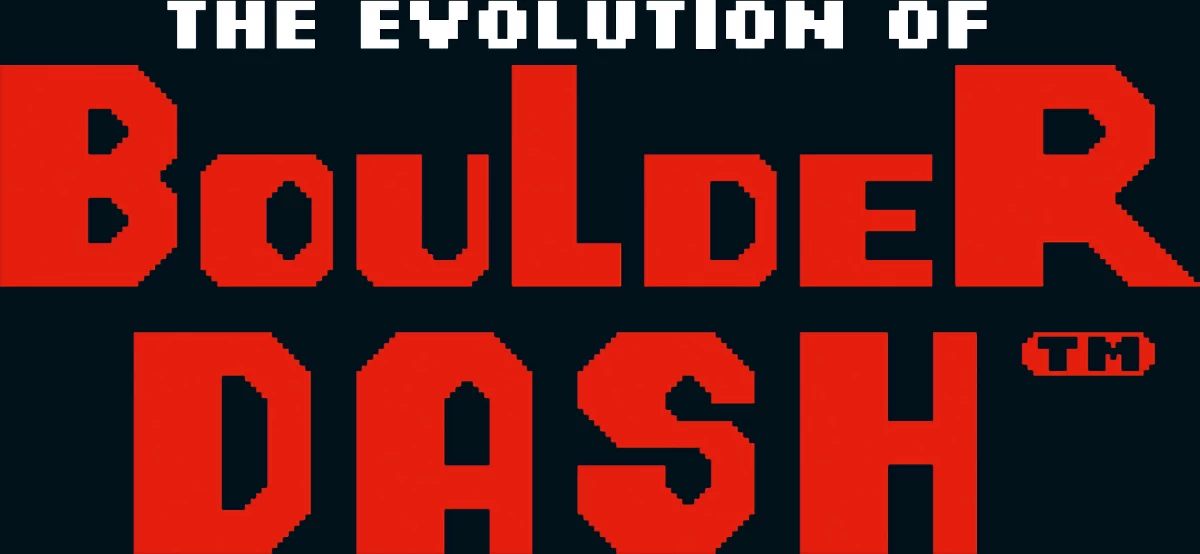
After wowing Atari 8-bit gamers in the mid-Eighties, First Star’s Boulder Dash went on to receive a number of followups. Creator Peter Liepa, First Star’s Richard Spitalny and IP owner Stephan Berendsen explain how the series evolved
WORDS BY RORY MILNE

» Boulder Dash creator Peter Liepa designed caves for the latest followups to his game.

» BBG Entertainment’s Stephan Berendsen is continuing the Boulder Dash series with Boulder Dash Deluxe.

» First Star founder Richard Spitalny oversaw all but the most recent Boulder Dash titles.
 ot all videogames begin as entirely fresh ideas. In fact, many take inspiration from existing concepts and then gradually evolve into something new. Take Boulder Dash, for example, which resembled a little known arcade game until Peter Liepa took over from its original developer Chris Gray. “Chris worked on a sort of a clone of a game called The Pit, which he wrote in BASIC,” Peter remembers, “and a local publishing house, In-home Software, was interested in it. It brought Chris and I together with the intent that I would help him commercialize it, but that intention evaporated very quickly as I realized that the rocks always rolled the same way each time you played it – because they were pre-programmed.”
ot all videogames begin as entirely fresh ideas. In fact, many take inspiration from existing concepts and then gradually evolve into something new. Take Boulder Dash, for example, which resembled a little known arcade game until Peter Liepa took over from its original developer Chris Gray. “Chris worked on a sort of a clone of a game called The Pit, which he wrote in BASIC,” Peter remembers, “and a local publishing house, In-home Software, was interested in it. It brought Chris and I together with the intent that I would help him commercialize it, but that intention evaporated very quickly as I realized that the rocks always rolled the same way each time you played it – because they were pre-programmed.”
Instead of converting Chris Gray’s game into assembly language, Peter transferred its core mechanics into a new project with gravity-affected boulders rather than on-rail rocks. “I basically started from scratch with a very simple simulation of physics. That was the backbone of the game,” Peter notes. “There was a mathematical concept called cellular automaton, where the idea was that cells changed state according to the cells around them. So I took that general idea and wrote rules for the rocks and gravity. It was like a black world, where everything was in a position on a grid. The rocks were just the letter O, and the dirt was probably just solid squares.” Initially, Boulder Dash lacked level designs and an objective – other than surviving, but its subterranean setting soon gave purpose to the game’s hostile environments. “Rather than design caves, I just had a random number generator that threw out rocks and dirt and space at random,” Peter explains, “and maybe in some cases I’d supplement that. Of course there also had to be motivation, so the jewels came in as a scoring mechanism, and then I had tangible goals: to pick up jewels and find the exit.”
“When I started adding enemies there were pursuits and flight – basically there were primal emotions that corresponded to the mathematical stuff on the screen”
PETER LIEPA
Other aspects of Boulder Dash’s initial design underwent changes too, such as its diminutive protagonist and the static caves he found himself in. “I had this little eight-by-eight pixel stick figure character – like the little guys in Choplifter,” Peter recollects. “But a fellow at In-home said he should be bigger and more recognisable.
The character I designed was a bug-like rodent with a striped shirt, I guess. Then the Atari made implementing scrolling fairly easy, because it was built for that sort of thing.”
![» [Atari 8-bit] Essentially a mobile obstacle, amoebas turn into jewels if you stop them growing.](https://boulder-dash.com/wp-content/uploads/2021/11/atari-8-bit.webp)
» [Atari 8-bit] Essentially a mobile obstacle, amoebas turn into jewels if you stop them growing.

» [Atari 8-bit] A lot of the fun in Boulder Dash stems from avoiding its deadly and unpredictable rocks.
As well as changing Boulder Dash’s fixed-screen caves into scrolling ones and giving its player character a makeover, Peter also gave his hero a trio of opponents. “The amoebas probably came from the game of Go, where you surround your enemy,” Peter considers.
“I probably thought it would be an interesting challenge to wall off an area with rocks. Then the butterflies and the fireflies were kind of the same, except that the fireflies exploded and destroyed things, and the butterflies exploded and made jewels.”
 oulder Dash’s butterflies hadn’t always turned into gems on their demise, however. In fact, the airborne enemies had originally tapped into native survival instincts. “When I started adding enemies there were pursuits and flight – basically there were primal emotions that corresponded to the mathematical stuff on the screen,” Peter points out. “But maybe I wanted to give an extra reward for killing the butterflies, by having them make jewels. So it became less about the satisfaction of killing and more just the way that you got jewels, which was a little less cold-blooded.”
oulder Dash’s butterflies hadn’t always turned into gems on their demise, however. In fact, the airborne enemies had originally tapped into native survival instincts. “When I started adding enemies there were pursuits and flight – basically there were primal emotions that corresponded to the mathematical stuff on the screen,” Peter points out. “But maybe I wanted to give an extra reward for killing the butterflies, by having them make jewels. So it became less about the satisfaction of killing and more just the way that you got jewels, which was a little less cold-blooded.”
As well as enemies, obstructive walls were added to Boulder Dash to encourage exploration, some of which let rocks fall through them that then became precious stones. “You had to explore to find the enchanted walls, and then activate them,” Peter observes. “That was the only way you would find them, because they otherwise looked identical to normal walls. Part of the puzzle was that you had to excavate below them, because if you didn’t you just lost whatever
you dropped through them.” As Boulder Dash’s development became less about creating elements and more about using them in cave designs, Peter set puzzles based on strategic path digging. “I would have noticed that one way of dealing with the enemies, and even harnessing them, was to dig diversions that they would follow,” Peter contemplates. “So maybe I did that, and then realised I could build a whole series of lairs for them. You would then have to lead them off somewhere, and figure out a way to dig paths while not getting killed by making everything too chaotic.”
Once its caves were complete, Peter offered Boulder Dash to First Star Software rather than his local publisher In-house, as First Star founder Richard Spitalny recalls. “We got a submission from Peter, which I opened,” Richard enthuses. “I started playing it, and I was hooked. Once we were partners on it we started giving him some feedback, like introducing more colour schemes and alternating between them. We also talked about being able to start at every fifth cave, and putting in static, non-scrolling puzzle screens, which turned into intermissions.”
With the tweaks suggested by First Star in place, Boulder Dash was released to a highly receptive public, and so work on a second game commenced shortly after.
“We were following up quickly with a sequel because the market was asking for one,” Richard reflects, “but instead of just making new caves we added some new gameplay elements. Each time we added an element there were unexpected consequences that didn’t appear until we did extensive testing, so between adding growing walls and slime we thought that was enough.”
THE EVOLUTION OF: BOULDER DASH
STAGES OF EVOLUTION:
ASSEMBLY
REQUIRED
RICHARD SPITALNY DISCUSSES THE BOULDER DASH CONSTRUCTION KIT
Why did you release a Boulder Dash title based on designing caves?
We thought that we would get the kind of sales that we had gotten on Boulder Dash and Boulder Dash II by doing a construction kit, and that people would love that. Fernando Herrera – one of the founders of the company – headed that up. It was what we thought would be the best way to get one more bite of the cherry, and then move on with other things. It should have been the end of the series.
What made you decide to include new pre-designed levels with the construction kit?
We were trying to provide value, and we wanted the best of both worlds. So if you wanted another Boulder Dash here it was – 15 new caves. But by the way, you could also make your own. So you
could do both or either. It was the fourth one in the series, so we tried to make it appealing by having a full game with an
editor added on.
Why did the kit have left-field options such as static, defenceless Rockfords?
Fernando was trying to make the editor as robust as possible, and every game element was a selectable sprite. So as you had a Rockford sprite then why not allow some that didn’t move? The thinking was in the context of this probably being the last Boulder Dash that we were going to do, so we gave the player everything that we could.
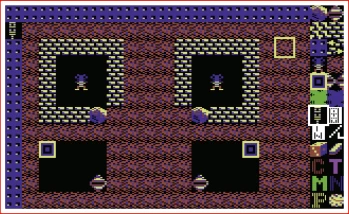
STAGES OF EVOLUTION:
ARCADE
ACTION
FIRST STAR FOUNDER RICHARD SPITALNY RECALLS THE BOULDER DASH COIN-OPS
What was the story behind the UK Boulder Dash coin-op Rockford?
Rockford was done with Arcadia
Systems, which was part of Mastertronic. Fernando Herrera designed it with Peter Liepa involved to a certain degree. As well as the coin-op, we had a deal with Mastertronic for a whole bunch of home systems – the Amiga, ST and others. My memory is that the various versions of Rockford were done concurrently, with Peter and Fernando working on the arcade version.
Why were players allowed to break free if Rockford got surrounded by rocks in Data East’s 1990 coin-op?
I think the idea of having a ‘rescue mode’ was just to get people to pay more money. The entire design for the Boulder Dash coin-op was entirely different from when you weren’t trying to get sequential payments. It was time-based, so being able to escape meant that you could continue to play for longer, and that you would put more money in to get more time.
Why did Data East split its 1990 Boulder Dash coin-op into themed worlds?
My sense is that Data East needed the eye candy. In the arcades, someone would be looking at a whole bunch of machines side by side. So the Boulder Dash coin-op had to look interesting. Also, because there were four worlds, players would think there was more to do and more to see – although that was much more of an impression of giving you more than actually doing that.
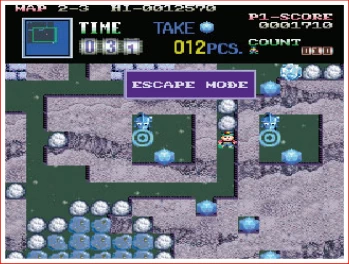
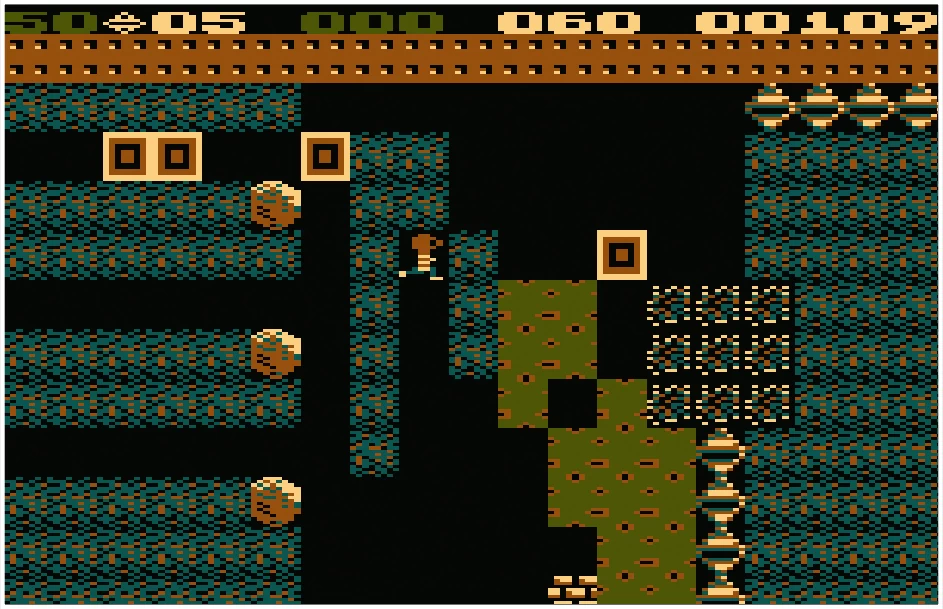
» [Atari 8-bit] In Boulder Dash II, you pit exploding fireflies against an amoeba to get to some jewels.
![]() he slime in Boulder Dash II acted as a barrier, through which jewels could fall through and become unreachable, although Peter Liepa has forgotten it entirely.
he slime in Boulder Dash II acted as a barrier, through which jewels could fall through and become unreachable, although Peter Liepa has forgotten it entirely.
“I don’t remember the slime,” Peter admits, “but I was clearly recycling the amoebas. I kind of remember it was a different colour, and I remember the word ‘slime’, but I have no recollection of the mechanics. Maybe I was just motivated for another puzzle category, but it wasn’t like I was hell-bent on introducing new characters or anything.”
Another new element of Boulder Dash II came in the form of a cave design where players pitted fireflies against amoebas, with the aim of clearing a path to some jewels.
“If I wanted fireflies and amoebas in the same cave then I had to make a choice about what happened when they made contact,” Peter ponders, “and I thought it would be fun if the fireflies exploded. The amoeba was essentially an obstacle, so I based a quest on that. The idea being that you had to blast your way through an amoeba.” The fresh challenges in the second Boulder Dash title went down well with gamers, as did those in Boulder Dash III, which was a surprise to First Star’s Richard Spitalny. “Boulder Dash III came out without our knowledge or permission,” Richard reveals. “Its designers just took our IP and added some new graphics and some new caves, which were mostly in black and white or black and red. So we contacted the publisher and shut it down, but then we worked out a deal where it re-did the packaging and we got royalties.”
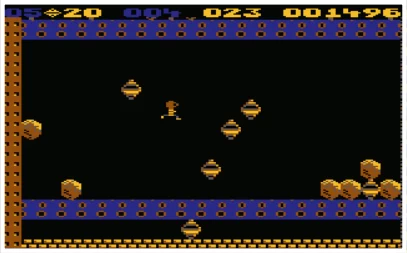
» [Atari 8-bit] The new enemy in Boulder Dash II is a slime that jewels fall through and become irretrievable
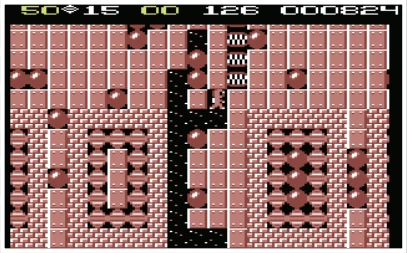
» [C64] Although unique to Boulder Dash III, its chattering teeth behave just like the original’s fireflies.

“I suggested we make a series of caves for Boulder Dash-XL that were puzzle-centric, for players who didn’t have quick refl exes or great hand-eye coordination”
RICHARD SPITALNY
![]() he Boulder Dash series continued with a cave-design package and two coin-ops, and then ten years later the power-up laden GBA title Boulder Dash EX was released. “I think the rotation power-up was to support the linked play, which was very cool!” Richard enthuses. “It worked really well in terms of the combat when you were playing against another player. Because if you got a rotation power-up, and used it at the right time, then you knew you were going to use it but your opponent didn’t. You could also play against the AI, but it supported up to four players, which was killer.”
he Boulder Dash series continued with a cave-design package and two coin-ops, and then ten years later the power-up laden GBA title Boulder Dash EX was released. “I think the rotation power-up was to support the linked play, which was very cool!” Richard enthuses. “It worked really well in terms of the combat when you were playing against another player. Because if you got a rotation power-up, and used it at the right time, then you knew you were going to use it but your opponent didn’t. You could also play against the AI, but it supported up to four players, which was killer.”
Three downloadable Boulder Dash games came out in the years after Boulder Dash EX, after which Boulder Dash Rocks! made good use of the unique hardware of the DS. “One of the modes was called Route Race,’” Richard beams, “where you looked at a cave, analysed what you had to do and then drew it with the stylus. Then you hit play, and what you had worked out would play out on the screen. Then Rockford needed to have oxygen when he was underwater, and I wanted to have boss fights, and all these new ideas were an attempt to take advantage of the platform we were on.”
After a short hiatus, the multiplatform release Boulder Dash-XL furthered Rockford’s adventures, which included a mode without opponents or time limits to worry about.
“Over the years, people had said to me that what they really liked was to figure out the solutions to the puzzles,” Richard says.
“So I suggested we make a series of caves for Boulder Dash-XL that were puzzle-centric, for players who didn’t have quick reflexes or great hand-eye coordination, but just wanted a mental challenge.
THE EVOLUTION OF: BOULDER DASH

That’s where the Puzzle Mode came from, and I designed a lot of the caves for that with an editor.” Another of Boulder Dash-XL’s innovations gave Richard doubts, more specifically its reimagining of series protagonist Rockford and alternate player character Crystal. “Yeah, that came from the graphic team,” Richard discloses. “That was something I struggled with over the years. We felt the little ant creature – or whatever you want to call Rockford – wasn’t that conducive to grandfather-ing from decade to decade. So his robot incarnation in Boulder Dash-XL was just another suggestion by a design team – I guess it was poetic license.”
More importantly, Boulder Dash-XL delivered on gameplay, as did the next instalment in the series, which Chris Gray produced with help from Richard Spitalny and Peter Liepa.
“Chris thought a modern version of Boulder Dash would really be something, so he and Richard Spitalny initiated the project,” Peter reviews.
“I think Chris thought of it as the band getting back together – like a reunion. Anyway, they showed me the prototypes that they had and talked me into it.”
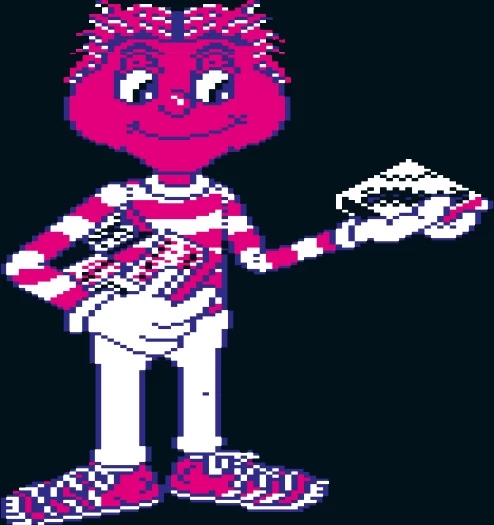

 s the joint project marked a major milestone, Boulder Dash 30th Anniversary looked to enhance the franchise’s core gameplay, which Peter used to inform his cave designs. “I agreed to do one of their worlds – so 20 caves. Then I examined the new mechanics, and I tried to build all of my levels around them,” Peter details. “All of a sudden there were new horizons to explore, so I’d really push things. Like there was no longer any fixed size for caves – they could be any dimensions. So I ended up with one that was five cells across and maybe 50 cells high, then I had to work out what I could put in that!”
s the joint project marked a major milestone, Boulder Dash 30th Anniversary looked to enhance the franchise’s core gameplay, which Peter used to inform his cave designs. “I agreed to do one of their worlds – so 20 caves. Then I examined the new mechanics, and I tried to build all of my levels around them,” Peter details. “All of a sudden there were new horizons to explore, so I’d really push things. Like there was no longer any fixed size for caves – they could be any dimensions. So I ended up with one that was five cells across and maybe 50 cells high, then I had to work out what I could put in that!”
The in-house Boulder Dash 30th Anniversary team created unlockable power-ups and heroes for the game, which Richard Spitalny thought should move in eight directions.
“One of the things that I asked for was ramps – which gave players the ability to move diagonally,” Richard remarks. “Other elements like unlocking power-ups and player characters with different abilities came from Chris.
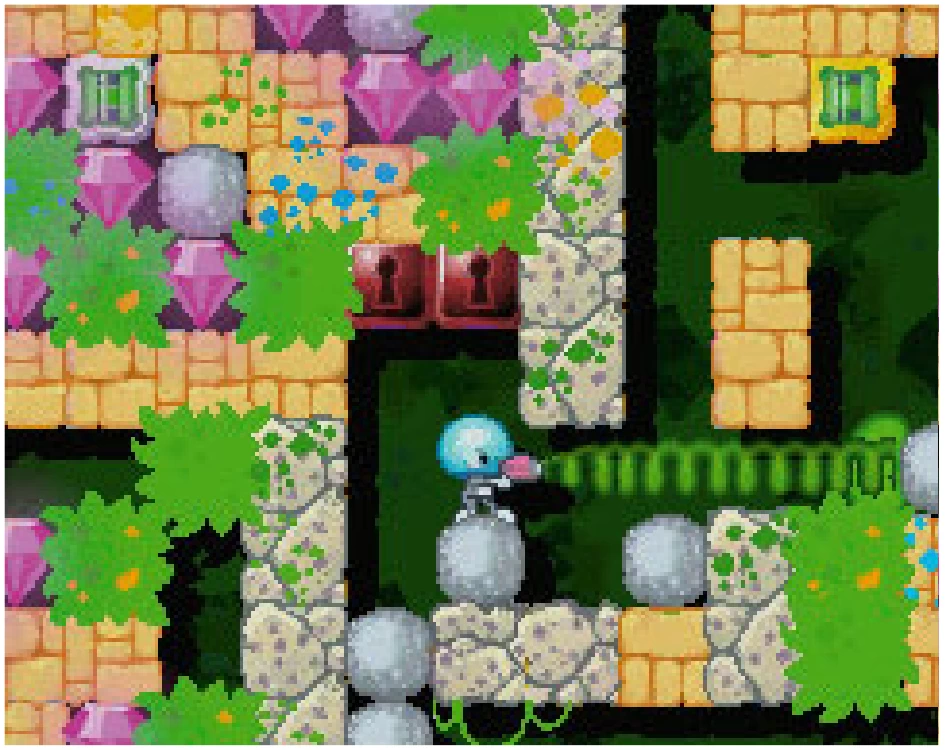
» [DS] In Boulder Dash Rocks! there are ranged weapons that can also be used to move obstructive rocks
It was initially a mobile title, so there was also a whole lot of treasure chests and gold. Many fans felt those elements took away from the game, but when a game’s free to play there are these things that one does.”
One aspect of Boulder Dash 30th Anniversary’s treasure hunts benefitted its gameplay, in that picking from the protagonists that the gold unlocked was a strategic choice. “Being able to play the same caves but with different skill sets based on the character you chose was different, and it was richer,” Richard argues.
“The unlockable characters put an emphasis on strategy, because you had to realise which of their abilities would fit the caves’ challenges.” Five years later, BBG Entertainment’s Boulder Dash Deluxe featured power-ups that players built from parts found in treasure chests, similar to those in its predecessor. “You don’t have to build power-ups,” Richard comments. “It’s just that if you want to play the game faster, instead of getting a speed power-up, you might build yourself some roller-skates. I think that’s great. I haven’t done it yet, but I’m looking forward to doing so – it sounds brilliant.”

» [GBA] The ‘rotate screen’ power-up is just one of Boulder Dash Ex’s contributions to the series.
» [DS] The boss fights in Boulder Dash Rocks! revolve around moving and dropping boulders.


![» [PC] The puzzle mode caves in Boulder Dash-XL involve very few elements, but they’re far from easy.](https://boulder-dash.com/wp-content/uploads/2021/12/BoulderDash-screenshot-10.webp)
» [PC] The puzzle mode caves in Boulder Dash-XL involve very few elements, but they’re far from easy.
“We said we’d do something new with fancy enemies that kids might like. For the older guys we have the retro world – that’s for them”
STEPHAN BERENDSEN
 esides introducing fresh mechanics, Boulder Dash Deluxe catered for both fans of the original and younger players, as BBG founder Stephan Berendsen explains. “Some older fans only want retro stuff, but of course we also want to introduce Boulder Dash to new gamers,” Stephan acknowledges. “So we said we’d do something new with fancy enemies that kids might like, and they can also design their player character – because younger players like to customise. For the older guys we have the retro world – that’s for them.”
esides introducing fresh mechanics, Boulder Dash Deluxe catered for both fans of the original and younger players, as BBG founder Stephan Berendsen explains. “Some older fans only want retro stuff, but of course we also want to introduce Boulder Dash to new gamers,” Stephan acknowledges. “So we said we’d do something new with fancy enemies that kids might like, and they can also design their player character – because younger players like to customise. For the older guys we have the retro world – that’s for them.”
![» [PC] One of Boulder Dash 30th Anniversary’s most striking foes is a dragon that turns into jewels.](https://boulder-dash.com/wp-content/uploads/2021/12/BoulderDash-screenshot-12.webp)
» [PC] One of Boulder Dash 30th Anniversary’s most striking foes is a dragon that turns into jewels.
![» [PC] As well as Rockford, you can play as the female character Crystal in Boulder Dash-XL.](https://boulder-dash.com/wp-content/uploads/2021/12/BoulderDash-screenshot-11.webp)
» [PC] As well as Rockford, you can play as the female character Crystal in Boulder Dash-XL.
Another aspect of Boulder Dash Deluxe aimed at those that appreciated the first game in the series was Liepa World, which of course took its name from its designer. “It’s 20 caves designed by Peter Liepa!” Stephan grins. “They took a while, because he always wants to do things perfectly – he’s not a guy who just does a quick job. But we’re very happy with them, and he was happy that he could be part of the series again, because it’s still his baby.”
As the holder of the Boulder Dash IP, Stephan is well-placed to chart the future of the popular franchise, and he has some interesting ideas for upcoming projects. “We want to make a multiplayer Boulder Dash, because people like to play against each other and with each other,” Stephan divulges. “It’s going to have more power-ups and new levels. Then also on our list is a VR version, where you’re under the earth in caves, which should be an amazing experience.”
It seems only fair that Boulder Dash creator Peter Liepa has the last word, which he uses to look back at his seminal work decades after it was revealed to the world. “It’s great to hear from people who played it as a kid,” Peter says proudly. “Boulder Dash was something I had complete control over, meaning that it was playing on a fixed platform, and I basically made all of the design decisions. It was designed to be fun, and I think that it holds up, so I’m very happy with it.”
![» [PC] Instead of butterflies, fireflies and amoebas, Boulder Dash Deluxe has new animal opponents such as sharks.](https://boulder-dash.com/wp-content/uploads/2021/12/BoulderDash-screenshot-13.webp)
» [PC] Instead of butterflies, fireflies and amoebas, Boulder Dash Deluxe has new animal opponents such as sharks
THE EVOLUTION OF: BOULDER DASH
STAGES OF EVOLUTION:
DIGITAL
DASHING
BOULDER DASH PUBLISHER RICHARD SPITALNY ON THE SERIES GOING ONLINE
What was the thinking behind making a brand-new Christmas Boulder Dash with party balloons?
Boulder Dash Xmas was released by a fi rm called Solware without our permission, and we told it that if it wanted to continue to publish the game then we needed to work out a partnership. The balloons were down to Solware wanting things that fl oated. It took one of the key elements of Boulder Dash, which was boulders falling, and it turned it on its head. So the balloons were an evolution.
Why was Boulder Dash Treasure Pleasure stuffed full of violent power-ups?
The graphics were cartoon-esque, so it didn’t strike me as violent. Also, we had explosions in the original Boulder Dash. Adding detonators, bombs and hammers was just us giving the player more abilities and options. To me, there was still a heavy emphasis on strategy, and you still had those moments of not believing you’d done something stupid!
Why did you decide to add an optional female protagonist to Boulder Dash Pirate’s Quest?
I was convinced that if you could play as a female character that there were a lot of women and girls who would want to do that, and as soon as we introduced her you saw so many female players on the online leaderboard! If Rockford and Crystal had different caves to play through it might have defeated what I was going after, which was equality. So it was the same game for both characters
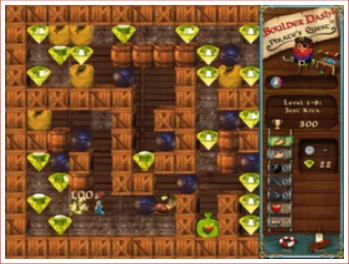
Thanks to retro GAMER for the permission to publish this article.
https://www.myfavouritemagazines.co.uk/retro-gamer-print-back-issues/
Boulder Dash® and Rockford® are trademarks of BBG Entertainment GmbH, registered in the US, the European Union and other countries. Boulder Dash® 30th Anniversary™, Boulder Dash® Deluxe™, Boulder Dash® 40th Anniversary™, Crystal™ and Goldford™ are trademarks of BBG Entertainment GmbH. Copyright © 1984-2025 BBG Entertainment GmbH. All rights reserved. The original Boulder Dash® was created by Peter Liepa with Chris Gray.